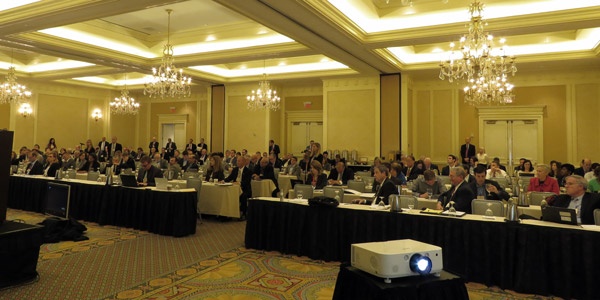COLUMBUS, Ohio — More than 150 regulators, PJM officials and stakeholders gathered for last week’s annual meeting of the Organization of PJM States Inc. Here’s some of what we heard.
Capacity Performance and Public Policy

American Public Power Association CEO Sue Kelly, who appeared on a panel on PJM’s Capacity Performance model with Independent Market Monitor Joe Bowring and RTO officials, Calpine and two utilities, noted that it was her fourth such appearance before OPSI. As the lone critic of mandatory capacity markets, she joked, she felt like “the token Republican on MSNBC.”
She said the changes going on “at the end of the grid,” such as solar and demand response, are going to make CP “outmoded.” It “does not meet public-policy goals. It wasn’t designed to meet public-policy goals,” she said.
PJM General Counsel Vince Duane said there are “a whole host” of “entirely valid” public-policy goals that PJM must balance in its designs. “So it’s not a question of which policies are more important,” he said. “There’s a lot of evidence out there that we’ve done the design job very well.”
The focus needs to be on developing the flexibility for states to make policy goals while ensuring the viability of CP, he said.
He said it’s a “gross over-reading” of the Supreme Court’s Hughes v. Talen ruling to believe that any state subsidy would interfere with wholesale markets. (See Supreme Court Rejects MD Subsidy for CPV Plant.) “We can’t let the markets be used to obscure and disenfranchise the political process,” he said.
Bowring repeated his concerns that competitive markets are threatened by state-subsidized generation, as proposed in Ohio. “There is a line, and the line has to do with price formation and the integrity of the market,” he said. “To the extent that the line isn’t drawn, then the markets won’t survive.”
Kelly said the Hughes case gives states and public power utilities “a lot of options” for implementing public policies without violating federal jurisdiction. “I don’t think we should just count on that court case to squash all of this. I think it would be much better if we collectively work this out than go back to the Supreme Court three more times,” she said.
Is the Coal-to-Gas Switch a Good Thing?

Lathrop Craig of Public Service Enterprise Group asked if a market dominated by gas, supported by renewables and experiencing major declines in coal “still makes a lot of sense” and whether a unit’s value to the market should rely on something other than its lack of emissions.
Bowring wasn’t in favor of what he described as subsidizing old units “because you don’t like where the market’s going.”
“I don’t think that’s a good idea,” he said.
Kelly raised concerns about relying too heavily on gas. “It’s kind of like dating your first husband — you have bad memories,” she said. “I have memories of gas at $3.50. I have memories of gas at $14.50. I have memories of having my contract ripped up by FERC and having to go out and replace all that.
“Things are great till they’re not great,” she added, citing concerns that fracking is causing earthquakes in Oklahoma and a rise in demand for LNG could boost gas prices.
Renewables on the Rise

In another panel, stakeholders discussed how state renewable portfolio standards are the largest driver of the surge in renewables on the grid. PJM’s Chantal Hendrzak outlined several initiatives the RTO is undertaking, including developing wind and solar forecasts and researching better integration of renewables and battery storage, to ensure that “when renewables come on the system, no matter how they come on the system, that we can reliably integrate them.”
The industry has moved quickly to implement states’ renewable portfolio standards, said Exelon’s Bill Berg. “Some of the lofty goals passed a few years ago now seems within reach,” he said.
Market Monitoring Meeting

As usual, the conference ended with OPSI’s Market Monitoring Advisory Committee’s meeting — an annual check-up on the status of relations between the Monitor and PJM.
Bowring said his “overall” relationship with PJM “is good,” but he noted one exception. He said the “very public” disagreement over how the Monitor interacts with PJM has resulted in “pretty tough filings back and forth on the hourly flexibility proceeding.” (See PJM Attempting to Usurp Market Mitigation Role, Monitor Says.)
Virginia State Corporation Commissioner Mark Christie commended Bowring, while noting that “not everyone agrees with” him.
“It is really all about making sure the markets are as efficient as possible, and we’ve always viewed the Independent Market Monitor as critical to that,” Christie said. “We certainly respect his honesty, his talent, his willingness to tell it like it is, like he sees it. Those who disagree can disagree.”
PJM Board Chairman Howard Schneider interjected, “We agree with that 100%.”
Earlier, Schneider had announced board member Susan Riley as the new chair of the Competitive Markets and Governance Committee, which oversees the engagement between PJM and the Monitor. Riley assured the audience that the committee has regular contact with Bowring, and he has unfettered access to bring issues to the board.
“Each issue that he raises is, in fact, researched with PJM, with Joe, with Joe’s staff, and we try to arrive at resolutions we can — more times than not — agree on,” she said. “The working relationship has evolved and grown over the past nine years, and I would say from where I sit that it’s working very well right now.”
Bowring agreed.
American Municipal Power’s Ed Tatum, who asked the only question during the brief meeting, appreciated the collegial tone. “The troubles are over. The waters are more still, and that’s good,” he said.
— Rory D. Sweeney






